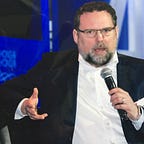Issue #3 of The Two But Rule
We Love Big Buts
How to Sculpt a Well-Formed But
We’ve established in previous issues that buts should come in pairs. Now it’s time to talk about what makes for a well-formed but.
The first secret to a well-formed but is to pick your buts wisely. Is the idea big enough to matter? Is it worth ruffling feathers and taking the conversation from passive assent to problem solving? Is the idea articulated enough to signal that it’s time to but in?
Case: Cars on a Map
Daniel Garcia had one of those amazing “dumb” ideas that lead to big results. Garcia was a Geek Squad Agent at big box retailer Best Buy in Los Angeles, California in the early days after the advent of the iPhone. He wanted customers who ordered home delivery and installation of appliances to see his car on an interactive map, so that they would know he was on his way. He thought that seeing the car on the map would be better for the customer, because they’d get a sense of when to be ready for arrival. And he thought it would be a fun thing to build. Bonus.
At that time, Best Buy was running a program for employees that gave them nine weeks to prove a new concept or line of business. Garcia was accepted to the program and joined a team of three, including USC students, Tal Flanchraych and Anthony Ko. The bunch quickly concluded that Geek Squad customers really didn’t need or want such a feature, not enough to warrant the effort of building and managing the application…at least not in those days.
Shortly thereafter, the team went to a party. Many failed attempts to find a cab left them grumbling, and the group returned home complaining about how they could never find a cab in Los Angeles. The geographic area of LA was so large compared to the number of taxis on the road that an available car might be right around the corner without you ever knowing it was there. And calling dispatch was a waste of time, especially on a Friday night.
The next day — lightbulbs. Suddenly they were imagining using a smartphone’s GPS and cellular connectivity to transmit the location of taxis and paint them on users’ smartphone screens. They spent the remainder of their nine weeks building a demo, which they called Cabulous after Flanchraych said, “Being able to see a taxi three blocks away and get them to pick me up would be cabulous.”
This led to the funding of a new company that operates today as Flywheel, and it helped to inspire the ridesharing industry. Notably, the ridesharing behemoth Uber partnered with Flywheel in 2022 to add taxis to the list of rides a passenger can hail with its app.
Path to a Big But:
What if we put Geek Squad cars on a map?
- But customers aren’t interested.
- BUT we could use the same approach to end the era of the invisible taxi.
The Best Buy case illustrates how a relatively small idea led to a really big but, one that helped shape the experience of getting a ride for hundreds of millions of people.
To Form Bigger Buts, Focus on the Why
What someone wants is never as interesting as why they want it. To stick with the automotive theme from our previous case, consider the old saw, attributed to Henry Ford:
“If I had asked what my customers wanted, they would have said they wanted a faster horse.”
The mistake most people make in that story is focusing on “horse” and not on “faster.” But faster doesn’t necessarily get you to cars. One might have said, “But horses can’t go faster, but maybe we could breed them for greater speed.” That’s a perfectly good pair of buts. However, it doesn’t get you to the automobile or any other form of faster transportation.
There are a lot of reasons why someone would have wanted to go faster in 1903. To get their produce to market before it went bad. To outrun predators (animal and human). To win races. But the mass adoption of Ford’s Model T was driven by a new rural middle class eager to show off its growing wealth and travel to leisure activities faster. These people wanted to show off. A faster horse wouldn’t do.
These specific users, and their specific requirements, came with a new set of buts that produced a completely different product. This was no longer just about going from horses to cars. It was about the type of car.
If, for example, Ford had chosen the goal of winning early car races on closed, paved tracks, then the Model T would have been completely different. Instead, the big but was that in 1903, there was a distinct lack of smooth paved roads in rural America. That led to Ford’s second-but: But we can make a car with big rubber tires and a lot of clearance to handle dirt roads.
Later, there was an even bigger but: “We want people to buy cars, but it’s the Great Depression, and the government needs to put people to work on big infrastructure projects.” Result? Today’s symbiotic relationship between the automotive industry and big government — the national highway system.
This is an important lesson, and it will show up in cases throughout this series:
If you want to have a better chance of finding high-octane buts, combine two completely different sets of intentions and see what happens.
In the next issue of The Two But Rule, we’ll look at someone who really knows how to play with truly enormous buts — Elon Musk.
Originally published at https://johnwolpert.substack.com on December 27, 2022.
